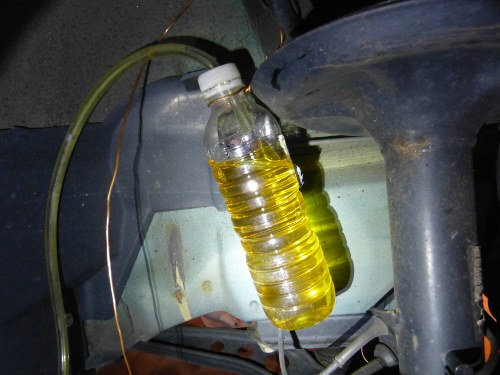Sunday, July 6, 2014
Brake Fluid Flush
 Usually I do the brake fluid flush as part of
a brake job but my ability to work long hours on this car in high heat and
humidity appear to be dwindling, so I wound up putting off the brake fluid
flush one week and tackled that job today.
Usually I do the brake fluid flush as part of
a brake job but my ability to work long hours on this car in high heat and
humidity appear to be dwindling, so I wound up putting off the brake fluid
flush one week and tackled that job today.
I have now purged TYP200 from the braking system enough times to recognize that as it ages its color changes from a slight yellow tint to a rich, deep gold, rather than brown as shown in my Brake Fluid Flush DIY article. TYP200 has higher wet and dry boiling points than standard DOT4, but the properties that give the fluid higher boiling points also make it more hygroscopic, so high performance fluids like TYP200 should probably be replaced more often than the standard DOT4 / factory stuff. TYP200's recommended replacement interval is three years so it's probably safe to say running it for two years is reasonable. In any case, I don't run TYP200 under the illusion that I'm getting better performance from this fluid on the street – I run it because it's functionally at least as good (initially anyway) and cheaper than the OE stuff.
I recently discovered TYP200 should not be used in newer vehicles equipped with DSC as BMW specifies a low viscosity fluid for that application, and if you buy fluid at the dealer that's what you'll get. There is no harm in running LV fluid in the E36, but no benefit either, particularly when paying dealer prices, so I will continue to use TYP200 in the E36.
As an aside, I
also learned our government's rampant liberalism has claimed another victim:
the NHTSA in its infinite wisdom and understanding of the needs of auto enthusiasts
everywhere has OUTLAWED ATE Super Blue (identical in chemical composition,
specifications, and applications to TYP200 except it is dyed blue). Now,
you wouldn't catch me dead using the stuff in my car because it stains plastic
and therefore makes it difficult impossible to see
the level in the reservoir but I'm
appalled at the princple that a government agency is wasting my
tax dollars outlawing something because it isn't their preferred color.
One new tip I heard from a pro tech: if you're wondering how much fluid to flush through the lines when it's very difficult to see where the old fluid ends and the new fluid begins, consider that passing a volume of 250ml through each rear brake line and 150ml through each front brake line is sufficient to flush the system. Just mark your waste bottle accordingly. Therefore, you'll need 800ml (a bit over ¾ of a liter) to flush the system properly. As expected I wound up using almost all of the 1 liter can of TYP200 and, as usual, I poured the remainder into my waste can since there's no point to keeping it – stored even with the cap screwed on tight it would age almost as quickly as the stuff in the car's reservoir.
Oh, and those ASC/ABS warnings? Coincidence or not, they appeared again a couple drive cycles after the brake fluid flush. Looks like I'll be paying a visit to my dealer eventually, but as I'm planning to take the car out of service next week I may just wait until I have to clear the SRS codes that will no doubt result from the upcoming interior work. Two birds, one stone.
Mileage: 250907



